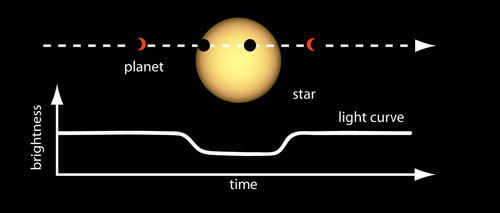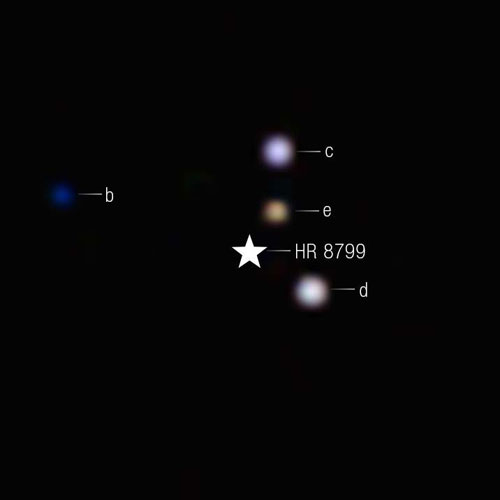| NIE Home | Sponsors | E FAQs | Order Form | Contact Us |
NASA's Night Sky Network

May’s Night Sky Notes: How Do We Find Exoplanets?
By: Dave Prosper
Updated by: Kat Troche
Astronomers have been trying to discover evidence that worlds exist around stars other than our Sun since the 19th century. By the mid-1990s, technology finally caught up with the desire for discovery and led to the first discovery of a planet orbiting another sun-like star, Pegasi 51b. Why did it take so long to discover these distant worlds, and what techniques do astronomers use to find them?
The Transit Method

A planet passing in front of its parent star creates a drop in the star’s apparent brightness, called a transit. Exoplanet Watch participants can look for transits in data from ground-based telescopes, helping scientists refine measurements of the length of a planet's orbit around its star.
Credit: NASA’s Ames Research Center
One of the most famous exoplanet detection methods is the transit method, used by Kepler and other observatories. When a planet crosses in front of its host star, the light from the star dips slightly in brightness. Scientists can confirm a planet orbits its host star by repeatedly detecting these incredibly tiny dips in brightness using sensitive instruments. If you can imagine trying to detect the dip in light from a massive searchlight when an ant crosses in front of it, at a distance of tens of miles away, you can begin to see how difficult it can be to spot a planet from light-years away! Another drawback to the transit method is that the distant solar system must be at a favorable angle to our point of view here on Earth – if the distant system's angle is just slightly askew, there will be no transits. Even in our solar system, a transit is very rare. For example, there were two transits of Venus visible across our Sun from Earth in this century. But the next time Venus transits the Sun as seen from Earth will be in the year 2117 – more than a century from now, even though Venus will have completed nearly 150 orbits around the Sun by then!
The Wobble Method

As a planet orbits a star, the star wobbles. This causes a change in the appearance of the star’s spectrum called Doppler shift. Because the change in wavelength is directly related to relative speed, astronomers can use Doppler shift to calculate exactly how fast an object is moving toward or away from us. Astronomers can also track the Doppler shift of a star over time to estimate the mass of the planet orbiting it.
Credit: NASA, ESA, CSA, Leah Hustak (STScI)
Spotting the Doppler shift of a star's spectra was used to find Pegasi 51b, the first planet detected around a Sun-like star. This technique is called the radial velocity or "wobble" method. Astronomers split up the visible light emitted by a star into a rainbow. These spectra, and gaps between the normally smooth bands of light, help determine the elements that make up the star. However, if there is a planet orbiting the star, it causes the star to wobble ever so slightly back and forth. This will, in turn, cause the lines within the spectra to shift ever so slightly towards the blue and red ends of the spectrum as the star wobbles slightly away and towards us. This is caused by the blue and red shifts of the planet's light. By carefully measuring the amount of shift in the star's spectra, astronomers can determine the size of the object pulling on the host star and if the companion is indeed a planet. By tracking the variation in this periodic shift of the spectra, they can also determine the time it takes the planet to orbit its parent star.
Direct Imaging
Finally, exoplanets can be revealed by directly imaging them, such as this image of four planets found orbiting the star HR 8799! Space telescopes use instruments called coronagraphs to block the bright light from the host star and capture the dim light from planets. The Hubble Space Telescope has captured images of giant planets orbiting a few nearby systems, and the James Webb Space Telescope has only improved on these observations by uncovering more details, such as the colors and spectra of exoplanet atmospheres, temperatures, detecting potential exomoons, and even scanning atmospheres for potential biosignatures!

Image taken by the James Webb Space Telescope of four exoplanets orbiting HR 8799.
Credit: NASA, ESA, CSA, STScI, Laurent Pueyo (STScI), William Balmer (JHU), Marshall Perrin (STScI)
You can find more information and activities on NASA's Exoplanets page, such as the Eyes on Exoplanets browser-based program, The Exoplaneteers, and some of the latest exoplanet news. Lastly, you can find more resources in our News & Resources section, including a clever demo on how astronomers use the wobble method to detect planets!
The future of exoplanet discovery is only just beginning, promising rich rewards in humanity's understanding of our place in the Universe, where we are from, and if there is life elsewhere in our cosmos.
Step onto any school campus and you'll feel its energy. Each school is turbocharged with the power of young minds, bodies, hearts and spirits.
Here on the Western Slope, young citizens are honing and testing their skills to take on a rapidly changing world. Largely thanks to technology, they are in the midst of the most profound seismic shift the world has ever seen.
Perhaps no time in our history has it been more important to know what our youth are thinking, feeling and expressing.
The Sentinel is proud to spotlight some of their endeavors. Read on to see how some thoroughly modern students are helping learners of all ages connect with notable figures of the past.
Online ordering
Now you can register online to start getting replica e-editions in your classroom.
Sponsors needed
Even small donations make a big difference in a child's education.
If you are interested in becoming a Partner In Education, please call 970-256-4299 or e-mail nie@GJSentinel.com
